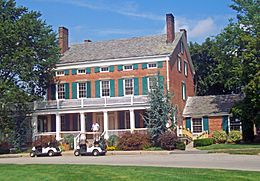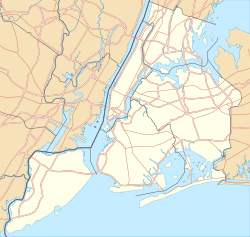La Tourette Golf Course facts for kids
 |
|
| Club information | |
|---|---|
| Coordinates | 40°34′34.00″N 74°8′50.00″W / 40.5761111°N 74.1472222°W |
| Location | Staten Island, New York, U.S. |
| Established | 1928 |
| Type | public |
| Total holes | 18 |
| Tournaments hosted | New York City Amateur |
| Website | https://www.latourettegc.com/ |
| Designed by | John R. Van Kleek |
| Par | 72 |
| Length | 6,708 yards |
| Course rating | 71.7 |
| Slope rating | 121 |
La Tourette Golf Course is a public golf course located on Staten Island in New York City. It's part of Staten Island's Greenbelt, a large area of parks and natural lands. From the course, you can see historic Richmond Town, which is like a living museum.
The beautiful La Tourette House, built in 1836, serves as the clubhouse. This historic building is even listed on the National Register of Historic Places. Many people think La Tourette Golf Course is one of the best public golf courses in New York City. It also hosts the yearly New York City Amateur Championship.
Contents
Discover La Tourette Golf Course
This section tells you all about the history and features of this famous golf course. Get ready to learn about its past and what makes it special today!
A Look Back: La Tourette's Story
Let's explore how La Tourette Golf Course came to be. It has a long and interesting history, starting as a family farm.
From Farm to Fairway
The land where La Tourette Park now stands was once a large farm. David and Ann La Tourette started their farm here in 1830. Their property grew to be 500 acres, making it the biggest private farm on Staten Island.
The La Tourette family farm was known for its amazing produce. They ran the farm successfully until 1910. In 1928, New York City bought 120 acres of the land. The city planned to build a public golf course for everyone to enjoy.
The property was later given to the parks department in 1955. In 1973, it was officially named a New York City Landmark. This means it's a special place protected for its history.
The first nine holes of the golf course opened in 1929. David L. Rees designed these original holes. Later, in 1935, John Van Kleek designed nine new holes. He also updated the first nine holes. A new restaurant area was added to the clubhouse around this time too. In 1964, Frank Duane made some changes to four of the holes.
Protecting Green Spaces
In the 1960s, there were plans to build a big road called the Richmond Parkway. This road is now known as the Korean War Veterans Parkway. Robert Moses, who was in charge of New York City's parks for many years, had a big plan for roads all over the city.
His plan for Staten Island included roads that would go right through the island's green spaces. This would have cut through parts of La Tourette Golf Course. However, many people on Staten Island loved their green spaces. They remembered how Frederick Law Olmsted, a famous landscape architect, had imagined miles of parkland there.
Because of strong community opposition, the plans for these roads through the middle of the island were stopped. The Parkway was built, but not through the golf course. This shows how important it is to protect natural areas.
Famous Golfers at La Tourette
Did you know a famous golfer once worked at La Tourette? Jim Albus was the head golf professional here from 1969 to 1980. He later became a multiple winner on the PGA Tour Champions. Jim Albus also won the important Metropolitan Open and the Senior Players Championship. He is a member of the PGA Metropolitan Section Hall of Fame.
Playing the Course: What to Expect
La Tourette Golf Course offers a fun challenge for golfers. Here's what you might find when you play a round.
Fun Features of the Course
The course has medium-sized greens, which are the smooth areas where you putt the ball. Some greens have different levels, like small hills (holes 1, 3, 6, 16, 17). Others have unique bumps and shapes (holes 4, 5, 7, 8, 12, 13, 15).
One of the tougher holes is the 5th, a par 4. It has trees hanging over the right side of the green. A big mound also splits the green into two parts. Many holes, like 4, 6, 10, 12, 13, 15, and 18, play uphill to the green. This means you hit the ball up a slope.
For the most part, you can see where you need to hit the ball. There are not many "blind shots" where you can't see your target. La Tourette used to have two practice putting greens. One was for flat putts, and the other for putts that curved. Today, they are mowed as one large practice green.
How the Course Has Changed
Since its last big update in 1964, the course has had some small changes. These changes help keep the course in good shape and make games faster. For example, a sand trap near the 1st green was removed.
In the 1970s, the 3rd green was made longer. This added about 35 yards to the hole. On the 4th hole, a large sand trap in the middle of the fairway was taken out. A second green was also built when a bike path was added nearby. Some greens, like the 7th and 12th, were made smaller. This changed some of their original unique shapes.
Also in the 1970s, a back tee on the 8th hole was cleared. This allowed players to hit over a lake. Some sand traps near the 9th hole that were not used were removed. Other sand traps near the 11th fairway, which protect a road, were fixed up. They had been left alone for years but were restored to protect the new bike path.
Course Details: The Scorecard
The scorecard gives you all the numbers for each hole. It shows the "par" (how many shots it should take) and the length of each hole.
| Tee | Rating/Slope | 1 | 2 | 3 | 4 | 5 | 6 | 7 | 8 | 9 | Out | 10 | 11 | 12 | 13 | 14 | 15 | 16 | 17 | 18 | In | Total |
|---|---|---|---|---|---|---|---|---|---|---|---|---|---|---|---|---|---|---|---|---|---|---|
| Par | Men/Women | 5 | 4 | 3 | 4 | 4 | 4 | 3 | 4 | 4 | 35 | 5 | 4 | 3 | 4 | 4 | 4 | 4 | 5 | 4 | 37 | 72 |
| Back | M:71.7/121 | 519 | 325 | 151 | 380 | 438 | 408 | 166 | 370 | 401 | 3158 | 511 | 382 | 200 | 417 | 354 | 394 | 397 | 497 | 414 | 3550 | 6708 |
| Middle | M:70.9/134 | 509 | 315 | 123 | 370 | 428 | 398 | 152 | 296 | 391 | 3046 | 481 | 372 | 137 | 392 | 344 | 384 | 387 | 431 | 398 | 3292 | 6338 |
| Forward | W:71.9/123 | 434 | 265 | 101 | 334 | 391 | 347 | 141 | 312 | 322 | 2647 | 467 | 284 | 131 | 377 | 306 | 282 | 285 | 402 | 296 | 2830 | 5477 |
| Handicap | Men | 13 | 15 | 17 | 7 | 1 | 3 | 11 | 9 | 5 | 16 | 14 | 10 | 2 | 18 | 4 | 8 | 12 | 6 | |||
| Handicap | Women | 5 | 13 | 15 | 7 | 1 | 3 | 17 | 11 | 9 | 4 | 14 | 16 | 2 | 18 | 6 | 12 | 8 | 10 |


